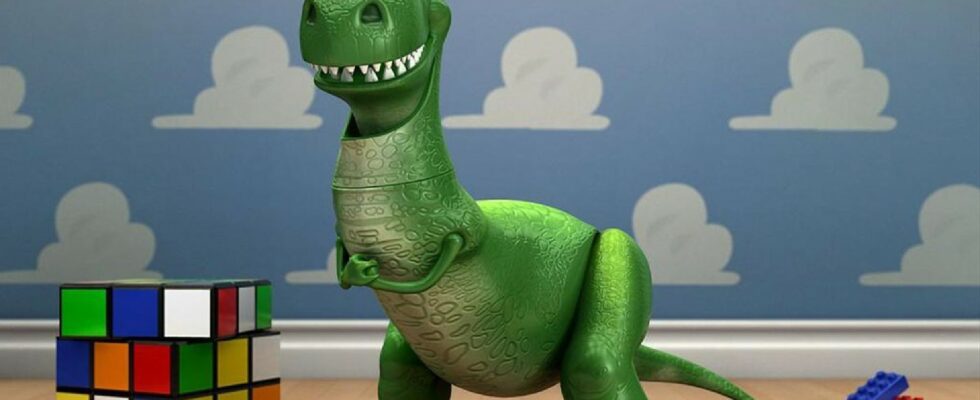Research has concluded that some dinosaurs, including the T.Rex, were potentially intelligent enough to “build tools” or “build a culture” on their own scale. But, the spectacular side of the remarks is to qualify, since it is about predictions. The scientific community seems divided.
The brain of the T.Rex, this famous carnivorous dinosaur, would have more than 3 billion neurons, according to work published at the end of December 2022. It is the equivalent of a baboon. This would be valid for other theropod dinosaurs like Allosaurus. A statement far from the popular image of these ancient living beings.
According to neurobiologist Suzanne Herculano-Houzel, lead author of this study, such a number of neurons ” means he had what it takes to build tools, solve problems and live to be 40, enough to build a culture “. Adding, in his tweet : “ The reality is even more terrifying than the movies! »
The scientist goes even further, answering a question from a user asking her what she means by “culture” for dinosaurs: “ How to uproot and use trees as toothpicks and spears. How to stealthily approach prey despite its size. How to conserve energy. How to identify and avoid eating sick animals. I’m making it all up right now, but the possibilities are endless… »
But how did Suzanne Herculano-Houzel and her team come to such a conclusion? And, given the somewhat spectacular dimension of Suzanne Herculano-Houzel’s remarks, at what point should we take it at face value?
Dinosaurs had as many neurons as primates according to this study
Studying the brain of dinosaurs is not without a major obstacle: brain tissue is not preserved on the scale of the millions of years that separate us from this distant era. In our time, computers come to the reinforcement of paleontology: when the cranial box is correctly fossilized, in good condition, we can mobilize tomography. If the scaling relationship between brain mass and number of neurons for the clade (grouping of species) is known, ” this relationship can be applied to estimate the neural composition of the brain writes Suzanne Herculano-Houzel in the introduction to the paper.
Suzanne Herculano-Houzel’s team then linked the cranial data of these dinosaurs with the data of similar species that exist today: birds, testudines (turtles), squamates (lizards, snakes, etc.). This amounts to extrapolating what we know of certain species, such as ostriches, to dinosaurs.
It is from this comparative analysis that they arrive at a conclusion. Theropod dinosaurs such as Tyrannosaurus and Allosaurus had a similar number of neurons to baboons (3 billion neurons), for the former, and apes (1 billion), for the latter. They would therefore not only be ferocious giants, but ” long-lived animals with flexible cognition “, and so ” even more magnificent predators than previously thought adds the study.
“ They were the primates of their time “says Suzanne Herculano-Houzel on her blog.
Between assumptions and new ideas, the intelligent T.Rex shares the scientists
Such assertions obviously make the scientific community react. Zoologist Kai Caspar, a specialist in primates, has produces a long thread highlighting some flaws of the study according to him. Several of these elements relate to the method of analysis itself — notions that he considers “ abstract “, which are not unanimous.
“It’s mostly guesswork”
Kai Caspar on Twitter
He also criticizes his conclusion of a potential use of tools and a culture “ simply because of a flawed prediction of the number of neurons “. Tools are not a generality among primates or birds, he writes. As for culture: There’s not even a consensus among primatologists on whether chimpanzees have social behaviors that qualify as culture, although we’ve studied them extensively for decades. In my opinion, launching discussions on this subject by focusing on dinosaurs is pointless. »
Kai Caspar also quite simply recalls the theoretical nature of such work: “ It goes without saying that these are mostly guesses and we have no way of knowing if they are correct. »
“I welcome the formulation of big ideas to advance science”
Amy Balanoff at the Washington Post
But scientists also believe that this work contributes to the building of an understanding of dinosaurs, and that this opens up new possibilities. ” The study as a whole is an important step in understanding the evolution of brain structure and function in modern birds. “, indicates the biologist Amy Balanoff, with Washington Post. As for the T.Rex’s ability to develop a culture, she believes the idea ” really fascinating “, but nuance all the same, it too:” I don’t know if we are already able to make this prediction. (…) That being said, I welcome the formulation of big ideas to advance science. »
According to her, it is a question of exploring this path by seeking more evidence. The fact of being open to a possibility makes it possible to open the horizon of the elements to be sought: If they were hunters, maybe you’ll find evidence that they hunted in groups using some sort of social communication. If you have no reason to expect that, you’re not going to look for that evidence. »

